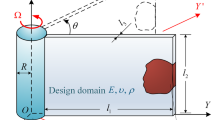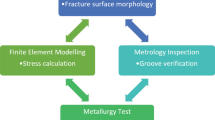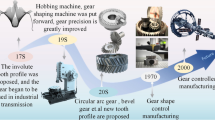Abstract
For the accurate calculation of the time-varying mesh stiffness (TVMS) of helical gear pairs, a novel method is proposed in this paper. This proposed method can predict the TVMS based on the gear accuracy grade or the measurement coordinates of the tooth surface. The abnormal meshing phenomena caused by manufacturing errors (MEs), assembly errors (AEs), and tooth modifications (TMs), such as the loss of contact of tooth pairs, out-of-line meshing, and eccentric loads, are considered in the calculation process. The proposed method was verified to be effective for both spur and helical gear pairs. The effects of MEs, AEs, and TMs on the TVMS of helical gear pairs were also investigated. The results showed that the pitch, helix, and misalignment deviations were the main influencing factors of the TVMS in MEs and AEs. Both profile modification and lead crowning reduced the mean of the TVMS. The proposed method is expected to provide accurate TVMS excitation data of gear transmission systems for dynamic analysis.


















Similar content being viewed by others
Abbreviations
- a :
-
Standard center distance between two gears
- A x :
-
Area of section
- B, B i :
-
Width of tooth and slice
- C a, C b :
-
Maximum modification amounts of profile modification and lead crowning
- C F :
-
Correction factor considering coupling effect between adjacent slices
- dx :
-
Coefficient defined in Fig. 7
- \(D_{{\text{g}}}^{\Delta Z}\) :
-
Minimum distance from arc \(\Gamma_{{\text{g}}}^{\Delta Z}\) center to arc \(\Gamma_{{\text{p}}}^{\Delta Z}\)
- \(D_{{\text{p}}}^{\Delta Z}\) :
-
Minimum distance from arc \(\Gamma_{{\text{p}}}^{\Delta Z}\) center to arc \(\Gamma_{{\text{g}}}^{\Delta Z}\)
- \(D_{{{\text{gp}}}}^{\Delta Z}\) :
-
Minimum distance between arc \(\Gamma_{{\text{g}}}^{\Delta Z}\) and \(\Gamma_{{\text{p}}}^{\Delta Z}\)
- e :
-
Calculation accuracy
- e c :
-
Coefficient of modification curve
- \(e_{{\text{g}}}^{i}\), \(e_{{\text{p}}}^{i}\) :
-
Initial gaps between axial slices
- E :
-
Young’s modulus
- E sni, E sns :
-
Lower and upper deviations of tooth thickness
- f pt :
-
Single pitch deviation
- F p :
-
Total cumulative pitch deviation
- F α :
-
Total profile deviation
- F β :
-
Helix deviation
- G :
-
Shear modulus
- h, h x :
-
Coefficients defined in Fig. 7
- i :
-
Index of discrete elements along tooth width
- i c :
-
Index of contacted tooth pairs
- i g, i p :
-
Index of slices where Hertzian contact center is located on gear and pinion
- I x :
-
Area moment of inertia
- j :
-
Index of discrete elements along tooth profile
- \(k_{{\text{a}}}^{ij}\) :
-
Axial compressive stiffness
- \(k_{{\text{b}}}^{ij}\) :
-
Bending stiffness
- \(k_{{\text{f}}}^{ij}\) :
-
Stiffness considering gear fillet-foundation deflection
- \(k_{{\text{f}}}^{ * }\), \(k_{{\text{f}}}^{i * }\) :
-
Correction foundation stiffnesses of gear and slice
- \(k_{{{\text{h\_}}i{\text{c}}}}^{t}\) :
-
Hertzian contact stiffness
- k mesh :
-
Time-varying mesh stiffness
- \(k_{{\text{s}}}^{ij}\) :
-
Shear stiffness
- \(k_{{{\text{tooth\_p,g\_}}i{\text{c}}}}^{t}\) :
-
Tooth stiffness of nominal slice \(S_{{{\text{N\_}}ic}}^{t}\) on tooth pair ic
- L :
-
Coefficient defined in Fig. 7
- L 1, L 2 :
-
Profile modification length and half of lead crowning length
- L *, M *, P *, Q * :
-
Coefficients in Eq. (27)
- n :
-
Index of teeth
- n 1, n 2 :
-
Number of discrete elements along tooth width and profile
- n 3 :
-
Number of contact tooth pairs
- n 4 :
-
Number of nominal slices on contact tooth pair ic
- n lg, n lp :
-
Half of number of uncontacted slices between current and last contact slices on gear and pinion
- n ng, n np :
-
Half of number of uncontacted slices between current and next contact slices on gear and pinion
- R :
-
Reference radius
- r b :
-
Radius of base circle
- \(r_{{\text{g}}}^{\Delta Z}\), \(r_{{\text{p}}}^{\Delta Z}\) :
-
Radii of arcs \(\Gamma_{{\text{g}}}^{\Delta Z}\) and \(\Gamma_{{\text{p}}}^{\Delta Z}\)
- \(r_{{\text{L}}}^{nij}\), \(r_{{\text{R}}}^{nij}\) :
-
Radii of circles where control points of elements \(\Sigma_{{\text{L}}}^{nij}\) and \(\Sigma_{{\text{R}}}^{nij}\) are located
- R pt(1), R Es(1), R α(1), R β(1):
-
Variables with a value range of [0, 1] and obey different probability distributions
- S 1, S 2 :
-
Modification distances of profile modification and lead crowning
- S f :
-
Coefficient defined in Fig. 7
- S i, \(S_{{\text{g}}}^{i}\), \(S_{{\text{p}}}^{i}\) :
-
Axial slices
- \(S_{{\text{N}}}^{t}\) :
-
Nominal slice
- t :
-
Index of contacted nominal slices
- T g :
-
Output torque of gear
- u f :
-
Coefficient defined in Fig. 7
- \(W_{{\text{F}}}^{i}\) :
-
Weighting factor of the slice Si
- W k :
-
Base tangent length
- x :
-
Coefficient defined in Fig. 7
- z :
-
Number of teeth
- \(X_{{\text{c}}}^{ij}\), \(Y_{{\text{c}}}^{ij}\), \(Z_{{\text{c}}}^{ij}\) :
-
Coordinates of center of curvature corresponding to control point of discrete element
- \(X_{L}^{{{1}ij}}\), \(Y_{{\text{L}}}^{1ij}\), \(Z_{{\text{L}}}^{1ij}\), \(X_{{\text{R}}}^{{{1}ij}}\), \(Y_{{\text{R}}}^{{{1}ij}}\), \(Z_{{\text{R}}}^{{{1}ij}}\) :
-
Theoretical coordinates of element control point on surfaces of first tooth
- \(X_{{{\text{MEL}}}}^{nij}\), \(Y_{{{\text{MEL}}}}^{nij}\), \(Z_{{{\text{MEL}}}}^{nij}\), \(X_{{{\text{MER}}}}^{nij}\), \(Y_{{{\text{MER}}}}^{nij}\), \(Z_{{{\text{MER}}}}^{nij}\) :
-
Coordinates of element control point considering manufacturing errors (MEs)
- \(X_{{{\text{TML}}}}^{nij}\), \(Y_{{{\text{TML}}}}^{nij}\), \(Z_{{{\text{TML}}}}^{nij}\), \(X_{{{\text{TMR}}}}^{nij}\), \(Y_{{{\text{TMR}}}}^{nij}\), \(Z_{{{\text{TMR}}}}^{nij}\) :
-
Coordinates of element control point considering MEs and tooth modifications (TMs)
- \(X_{{{\text{AEL}}}}^{nij}\), \(Y_{{{\text{AEL}}}}^{nij}\), \(Z_{{{\text{AEL}}}}^{nij}\), \(X_{{{\text{AER}}}}^{nij}\), \(Y_{{{\text{AER}}}}^{nij}\), \(Z_{{{\text{AER}}}}^{nij}\) :
-
Coordinates of element control point considering MEs, TMs, and assembly errors (AEs)
- β :
-
Helix angle of reference circle
- β j :
-
Coefficient defined in Fig. 7
- δ f, δ g :
-
Foundation deflections
- \(\delta_{{{\text{N\_}}i_{{\text{c}}} }}^{t}\) :
-
Comprehensive deflection of nominal slice
- \(\delta_{{i_{{\text{c}}} }}^{t}\) :
-
Total deflection of contact center of nominal slice
- Δ1, Δ2 :
-
Modification amounts of profile modification and lead crowning
- Δsum :
-
Total amount of TMs
- Δx, Δy :
-
Center distance deviations along X-axis and Y-axis
- ΔZ :
-
Distance between centers of arc \(\Gamma^{\Delta Z}\) and arc corresponding to element control point
- Δθ 1, Δθ 2 :
-
Rotation steps of gear and pinion
- Δθ c :
-
Angle parameter used for calculating center coordinates of arc \(\Gamma^{\Delta Z}\)
- \(\Delta \theta_{{{\text{MEL}}}}^{nij}\), \(\Delta \theta_{{{\text{MER}}}}^{nij}\) :
-
Angle parameters used for generating tooth surfaces with MEs in Eqs. (5) and (6)
- \(\Delta \theta_{{{\text{TML}}}}^{nij}\), \(\Delta \theta_{{{\text{TMR}}}}^{nij}\) :
-
Angle parameters used to generate tooth surfaces with TMs in Eqs. (12) and (13)
- \(\Sigma_{{\text{L}}}^{nij}\), \(\Sigma_{{\text{R}}}^{nij}\) :
-
Discrete elements on tooth surfaces
- \(\Sigma^{\Delta Z}\) :
-
Plane perpendicular to Z-axis
- \(\Gamma^{\Delta Z}\) :
-
Arc on discrete element
- υ :
-
Poisson’s ratio
- θ 1, θ 2 :
-
Rotation angles of gear and pinion during iterative process for calculating time-varying mesh stiffness (TVMS)
- θ f :
-
Coefficient defined in Fig. 7
- φ, γ :
-
Misalignment deviations on XBpZ-plane and YBpZ-plane
- η, λ :
-
Correction coefficients of foundation stiffness
- AEs:
-
Assembly errors
- FEM:
-
Finite element method
- MEs:
-
Manufacturing errors
- TCA:
-
Tooth contact analysis
- TMs:
-
Tooth modifications
- TVMS:
-
Time-varying mesh stiffness
References
Chen Z, Zhou Z, Zhai W, Wang K (2020) Improved analytical calculation model of spur gear mesh excitations with tooth profile deviations. Mech Mach Theory 149:103838
Chen Z, Shao Y (2011) Dynamic simulation of spur gear with tooth root crack propagating along tooth width and crack depth. Eng Fail Anal 18:2149–2164
Pimsarn M, Kazerounian K (2002) Efficient evaluation of spur gear tooth mesh load using pseudo-interference stiffness estimation method. Mech Mach Theory 37:769–786
Wang J, Howard I (2004) The torsional stiffness of involute spur gears. Proc IMechE Part C J Mech Eng Sci 218:131–142
Yuan B, Chang S, Liu G, Wu L (2018) Quasi-static and dynamic behaviors of helical gear system with manufacturing errors. Chin J Mech Eng 31:30
Ma H, Yang J, Song R, Zhang S, Wen B (2014) Effects of tip relief on vibration responses of a geared rotor system. Proc IMechE Part C J Mech Eng Sci 228:1132–1154
Shao Y, Chen Z, Wang S (2009) Simulation of spur gear pair with faults using FEA. In: ICROS-SICE international joint conference, Fukuoka, Japan, pp 2607−2610
Cooley CG, Liu C, Dai X, Parker RG (2016) Gear tooth mesh stiffness: a comparison of calculation approaches. Mech Mach Theory 105:540–553
Yu W, Mechefske CK (2019) A new model for the single mesh stiffness calculation of helical gears using the slicing principle. Iran J Sci Technol Trans Mech Eng 43:503–515
Huangfu Y, Chen K, Ma H, Che L, Li Z, Wen B (2019) Deformation and meshing stiffness analysis of cracked helical gear pairs. Eng Fail Anal 95:30–46
Cornell RW (1981) Compliance and stress sensitivity of spur gear teeth. ASME J Mech Des 103:447–459
Weber C (1949) The deformation of loaded gears and the effect on their load carrying capacity. Sponsored research (Germany). British Department of Science and Research, Report No. 3
Sainsot P, Velex P, Duverger O (2004) Contribution of gear body to tooth deflections: a new bidimensional analytical formula. ASME J Mech Des 126:748–752
Chen ZG, Zhang J, Zhai WM, Wang YW, Liu JX (2017) Improved analytical methods for calculation of gear tooth fillet-foundation stiffness with tooth root crack. Eng Fail Anal 82:72–81
Yang DCH, Lin JY (1987) Hertzian damping, tooth friction and bending elasticity in gear impact dynamics. J Mech Trans Automat Des 109:189–196
Tian XH (2004) Dynamic simulation for system response of gearbox including localized gear faults. M.S. thesis, University of Alberta, Canada
Wu S, Zuo MJ, Parey A (2008) Simulation of spur gear dynamics and estimation of fault growth. J Sound Vib 317:608–624
Chaari F, Fakhfakh T, Haddar M (2009) Analytical modelling of spur gear tooth crack and influence on gearmesh stiffness. Eur J Mech A/Solids 28:461–468
Wan Z, Cao H, Zi Y, He W, He Z (2014) An improved time-varying mesh stiffness algorithm and dynamic modeling of gear-rotor system with tooth root crack. Eng Fail Anal 42:157–177
Chen Z, Shao Y (2013) Mesh stiffness calculation of a spur gear pair with tooth profile modification and tooth root crack. Mech Mach Theory 62:63–74
Kahraman A, Blankenship GW (1999) Effect of involute contact ratio on spur gear dynamics. ASME J Mech Des 121:112–118
Lin J, Parker RG (2002) Planetary gear parametric instability caused by mesh stiffness variation. J Sound Vib 249:129–145
Lin J, Parker RG (2002) Mesh stiffness variation instabilities in two-stage gear systems. J Vib Acoust 124:68–76
Wang Q, Zhang Y (2015) A model for analyzing stiffness and stress in a helical gear pair with tooth profile errors. J Vib Control 23:272–289
Wan Z, Cao H, Zi Y, He W, Chen Y (2015) Mesh stiffness calculation using an accumulated integral potential energy method and dynamic analysis of helical gears. Mech Mach Theory 92:447–463
Jiang H, Liu F (2020) Mesh stiffness modelling and dynamic simulation of helical gears with tooth crack propagation. Meccanica 55:1215–1236
Han L, Xu L, Qi H (2017) Influences of friction and mesh misalignment on time-varying mesh stiffness of helical gears. J Mech Sci Technol 31:3121–3130
Feng M, Ma H, Li Z, Wang Q, Wen B (2018) An improved analytical method for calculating time-varying mesh stiffness of helical gears. Meccanica 53:1131–1145
Marques P, Martins R, Seabra J (2017) Analytical load sharing and mesh stiffness model for spur/helical and internal/external gears. Mech Mach Theory 113:126–140
Cao X, Deng X, Wei B (2018) A novel method for gear tooth contact analysis and experimental validation. Mech Mach Theory 126:1–13
Ma H, Zeng J, Feng R, Pang X, Wen B (2016) An improved analytical method for mesh stiffness calculation of spur gears with tip relief. Mech Mach Theory 98:64–80
Chen K, Huangfu Y, Ma H, Xu Z, Li X, Wen B (2019) Calculation of mesh stiffness of spur gears considering complex foundation types and crack propagation paths. Mech Syst Signal Process 130:273–292
Kurokawa S, Ariura Y, Ohtahara M (1996) Transmission errors of cylindrical gears under load-influence of tooth profile modification and tooth deflection. In: Proceedings of 7th ASME international power transmission and gearing conference, San Diego, USA, pp 213−217
Hu Z, Tang J, Zhong J, Chen S, Yan H (2016) Effects of tooth profile modification on dynamic responses of a high gear-totor-bearing system. Mech Syst Signal Process 76–77:294–318
Fernández-del-Rincón A, Iglesias M, de-Juan A, Diez-Ibarbia A, García P, Viadero F (2016) Gear transmission dynamics: Effects of index and run out errors. Appl Acoust 108:63–83
ISO 1328/1 (2013) Cylindrical gears-ISO system of flank tolerance classification-part 1: definitions and allowable values of deviations relevant to flanks of gear teeth, pp 1−50
Chaari F, Baccar W, Abbes MS, Haddar M (2008) Effect of spalling or tooth breakage on gearmesh stiffness and dynamic response of a one-stage spur gear transmission. Eur J Mech A/solids 27:691–705
Wang J (2003) Numerical and experimental analysis of spur gears in mesh. PhD thesis, Curtin University of Technology, Australia
Ajmi M, Velex P (2005) A model for simulating the quasi-static and dynamic behaviour of solid wide-faced spur and helical gears. Mech Mach Theory 40:173–190
Yang DCH, Sun ZS (1985) A rotary model for spur gear dynamics. J Mech Trans Automat Des 107:529–535
Xie C, Hua L, Han X, Lan J, Wan X, Xiong X (2018) Analytical formulas for gear body-induced tooth deflections of spur gears considering structure coupling effect. Int J Mech Sci 148:174–190
Acknowledgements
The authors are grateful for the financial support from the NSFC. This research was funded by the National Natural Science Foundation of China (No. 51675061).
Author information
Authors and Affiliations
Corresponding author
Ethics declarations
Conflict of interest
All the authors declare that they have no conflicts of interest.
Additional information
Publisher's Note
Springer Nature remains neutral with regard to jurisdictional claims in published maps and institutional affiliations.
Rights and permissions
About this article
Cite this article
Liu, C., Shi, W. & Liu, K. Calculation method of mesh stiffness for helical gear pair with manufacturing errors, assembly errors and tooth modifications. Meccanica 57, 541–565 (2022). https://doi.org/10.1007/s11012-022-01479-8
Received:
Accepted:
Published:
Issue Date:
DOI: https://doi.org/10.1007/s11012-022-01479-8




